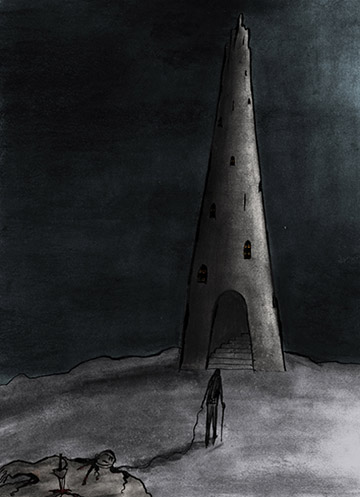Elle Ward
Elle was born in London in 1986. She graduated from the Kingston University in 2008 and has been working full-time as a designer in book publishing since then. Her work, published by Carlton Books, includes 3 children’s activity books, and two more are to be released in 2011. She is open for commissions.
Old Book Illustrations: Most of your drawings are unadorned, uncluttered with anything that isn’t necessary, they are often very expressive too, in an unsettling, coarse sort of way: you don’t try to charm the viewer, and you seem to stay away from “pretty” with great care. Is this approach easy to live with? Or have you felt some pressure along the way to alter your artistic personality, and, shall we say, smooth the rough edges?
Elle Ward – My work has always had a dark side to it. I find drawing pretty things to be almost too easy, not challenging enough to the artist or the viewer. I’m at my happiest when illustrating something unsettling, macabre or strange. The problem with this is that what I like drawing isn’t necessarily what works best commercially – I’ve got quite a black sense of humour which doesn’t always sit well with current trends in illustration. So yes, at times I’ve felt pressurised to produce work that’s a bit nicer, softer and prettier. But this has never really worked – I’ve come to realise I’m at my best when doing what I enjoy.
Visit Elle Ward’s website:
Elle Ward Illustration
Or
You may also
OBI: Your Ages of Fear series is a good example of those unsettling and minimalist aspects of your work. Very few objects or characters take part in your scenes, but everything is used to produce the strongest effect: the sophisticated shades of gray, the distorted perspectives, the suggested bodies or silhouettes, enclosed in spaces filled with unspoken terrors… There is a threatening silence and stillness in those pictures, and although nothing directly terrifying is shown, everything is ready for our own fears to crawl out. You don’t really show us what scary things you can draw, but try to make us feel what it’s like to be scared instead. Is that what you’d say you’re aiming at: sharing particular experiences and feelings more than mental images or imaginary worlds?
E. W. – In Ages of Fear I didn’t want to show the obvious. Looking at a drawing of a wolf isn’t as powerful as looking at an image of a dark forest, waiting for the wolf to jump out. I think fear is not a rational thing, not something you can draw or label, and so I tried to suggest it rather than explicitly show it. I wanted you to be able to almost experience the fear yourself, to be part of the image. The series is linked to age, depicting the fears people experience throughout their lifetime, and I know people usually identify with one of the fears more than the others. I intended the series to be thought provoking, to make you see things slightly differently.

OBI: You make use of a variety of techniques in your work, from the black and white etched prints of Ages of Fear, to the drawings for Edward Lear’s nonsense verses, enhanced with flat colors, to the charcoaled drawings for Mervyn Peake’s Gormenghast… Can you tell us more about your technical choices and preferences, about working with ink and your attention to the expressiveness of the lines?
E. W. – My favourite medium is dip pen and ink – I love the way ink is fluid, expressive and unpredictable. There’s always an element of surprise, as every line is different. You can start drawing and not quite know how it will turn out! Nearly all my work involves some sort of ink line, even my etched prints. These were very complicated, involving screen-printing a pen and ink drawing onto a steel plate, which was then etched and repeatedly aquatinted to create the depth of shadows you see in the final prints. I also use paint, watercolour washes, and digital colouring, depending on what fits the image.
OBI: Your recent, as well as soon-to-be published work includes several children’s books, which seems somehow consistent with your illustrations for E. Lear’s verses. Is working on childhood, an age where the uncanny hides beneath every familiar surface, something that you’d like to do more particularly? Or do you already have other plans?
E. W. – My recent children’s books have been a bit of a change of direction for me. They are all activity books, on a range of subjects, mostly done in felt tip, but some in pen and ink. Because they’re for children, they’re all very cheerful, which took me a while to get used to! I enjoy the variety of drawing so many different things, and the way I can have fun with the line-work without thinking too hard about the meaning behind the pictures, but I do miss the darker side of my work. I plan to continue with my children’s line drawings, but I’m looking forward to doing some more illustrations for an adult audience soon. Hopefully, I‘ll carry on doing a bit of both!
More interviews from the Present Tense section »
All the pictures included in this article are copyrighted to Elle Ward.
If you would like to be the illustrator featured in this section, please read our guidelines.







